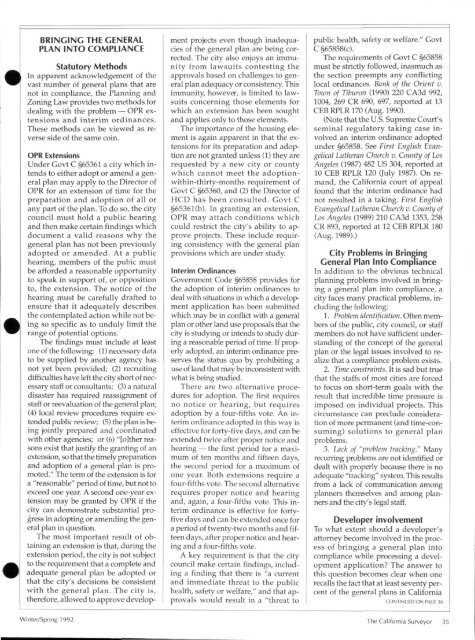You also want an ePaper? Increase the reach of your titles
YUMPU automatically turns print PDFs into web optimized ePapers that Google loves.
^^k<br />
^^<br />
•<br />
•<br />
BRINGING THE GENERAL<br />
PLAN INTO COMPLIANCE<br />
Statutory Methods<br />
In apparent acknowledgement of the<br />
vast number of general plans that are<br />
not in compliance, the Planning and<br />
Zoning Law provides two methods <strong>for</strong><br />
dealing with the problem — OPR extensions<br />
and interim ordinances.<br />
<strong>The</strong>se methods can be viewed as reverse<br />
side of the same coin.<br />
OPR Extensions<br />
Under Govt C §65361 a city which intends<br />
to either adopt or amend a general<br />
plan may apply to the Director of<br />
OPR <strong>for</strong> an extension of time <strong>for</strong> the<br />
preparation and adoption of all or<br />
any part of the plan. To do so, the city<br />
council must hold a public hearing<br />
and then make certain findings which<br />
document a valid reasons why the<br />
general plan has not been previously<br />
adopted or amended. At a public<br />
hearing, members of the pubic must<br />
be af<strong>for</strong>ded a reasonable opportunity<br />
to speak in support of, or opposition<br />
to, the extension. <strong>The</strong> notice of the<br />
hearing must be carefully drafted to<br />
ensure that it adequately describes<br />
the contemplated action while not being<br />
so specific as to unduly limit the<br />
range of potential options.<br />
<strong>The</strong> findings must include at least<br />
one of the following: (1) necessary data<br />
to be supplied by another agency has<br />
not yet been provided; (2) recruiting<br />
difficulties have left the city short of necessary<br />
staff or consultants; (3) a natural<br />
disaster has required reassignment of<br />
staff or reevaluation of the general plan;<br />
(4) local review procedures require extended<br />
public review; (5) the plan is being<br />
jointly prepared and coordinated<br />
with other agencies; or (6) "[o]ther reasons<br />
exist that justify the granting of an<br />
extension, so that the timely preparation<br />
and adoption of a general plan is promoted."<br />
<strong>The</strong> term of the extension is <strong>for</strong><br />
a "reasonable" period of time, but not to<br />
exceed one year. A second one-year extension<br />
may be granted by OPR if the<br />
city can demonstrate substantial progress<br />
in adopting or amending the general<br />
plan in question.<br />
<strong>The</strong> most important result of obtaining<br />
an extension is that, during the<br />
extension period, the city is not subject<br />
to the requirement that a complete and<br />
adequate general plan be adopted or<br />
that the city's decisions be consistent<br />
with the general plan. <strong>The</strong> city is,<br />
there<strong>for</strong>e, allowed to approve development<br />
projects even though inadequacies<br />
of the general plan are being corrected.<br />
<strong>The</strong> city also enjoys an immunity<br />
from lawsuits contesting the<br />
approvals based on challenges to general<br />
plan adequacy or consistency. This<br />
immunity, however, is limited to lawsuits<br />
concerning those elements <strong>for</strong><br />
which an extension has been sought<br />
and applies only to those elements.<br />
<strong>The</strong> importance of the housing element<br />
is again apparent in that the extensions<br />
<strong>for</strong> its preparation and adoption<br />
are not granted unless (1) they are<br />
requested by a new city or county<br />
which cannot meet the adoptionwithin-thirty-months<br />
requirement of<br />
Govt C §65360, and (2) the Director of<br />
HCD has been consulted. Govt C<br />
§65361 (b). In granting an extension,<br />
OPR may attach conditions which<br />
could restrict the city's ability to approve<br />
projects. <strong>The</strong>se include requiring<br />
consistency with the general plan<br />
provisions which are under study.<br />
Interim Ordinances<br />
Government Code §65858 provides <strong>for</strong><br />
the adoption of interim ordinances to<br />
deal with situations in which a development<br />
application has been submitted<br />
which may be in conflict with a general<br />
plan or other land use proposals that the<br />
city is studying or intends to study during<br />
a reasonable period of time. If prop<br />
erly adopted, an interim ordinance preserves<br />
the status quo by prohibiting a<br />
use of land that may be inconsistent with<br />
what is being studied.<br />
<strong>The</strong>re are two alternative procedures<br />
<strong>for</strong> adoption. <strong>The</strong> first requires<br />
no notice or hearing, but requires<br />
adoption by a four-fifths vote. An interim<br />
ordinance adopted in this way is<br />
effective <strong>for</strong> <strong>for</strong>ty-five days, and can be<br />
extended twice after proper notice and<br />
hearing — the first period <strong>for</strong> a maximum<br />
of ten months and fifteen days,<br />
the second period <strong>for</strong> a maximum of<br />
one year. Both extensions require a<br />
four-fifths vote. <strong>The</strong> second alternative<br />
requires proper notice and hearing<br />
and, again, a four-fifths vote. This interim<br />
ordinance is effective <strong>for</strong> <strong>for</strong>tyfive<br />
days and can be extended once <strong>for</strong><br />
a period of twenty-two months and fifteen<br />
days, after proper notice and hearing<br />
and a four-fifths vote.<br />
A key requirement is that the city<br />
council make certain findings, including<br />
a finding that there is "a current<br />
and immediate threat to the public<br />
health, safety or welfare," and that approvals<br />
would result in a "threat to<br />
public health, safety or welfare." Govt<br />
C §65858(c).<br />
<strong>The</strong> requirements of Govt C §65858<br />
must be strictly followed, inasmuch as<br />
the section preempts any conflicting<br />
local ordinances. Bank of the Orient v.<br />
Town of Tiburon (1990) 220 CA3d 992,<br />
1004, 269 CR 690, 697, reported at 13<br />
CEB RPLR 170 (Aug. 1990).<br />
(Note that the U.S. Supreme Court's<br />
seminal regulatory taking case involved<br />
an interim ordinance adopted<br />
under §65858. See First English Evangelical<br />
Lutheran Church v. County of Los<br />
Angeles (1987) 482 US 304, reported at<br />
10 CEB RPLR 120 (July 1987). On remand,<br />
the Cali<strong>for</strong>nia court of appeal<br />
found that the interim ordinance had<br />
not resulted in a taking. First English<br />
Evangelical Lutheran Church v. County of<br />
Los Angeles (1989) 210 CA3d 1353, 258<br />
CR 893, reported at 12 CEB RPLR 180<br />
(Aug. 1989).)<br />
City Problems in Bringing<br />
General Plan Into Compliance<br />
In addition to the obvious technical<br />
planning problems involved in bringing<br />
a general plan into compliance, a<br />
city faces many practical problems, including<br />
the following:<br />
1. Problem identification. Often members<br />
of the public, city council, or staff<br />
members do not have sufficient understanding<br />
of the concept of the general<br />
plan or the legal issues involved to realize<br />
that a compliance problem exists.<br />
2. Time constraints. It is sad but true<br />
that the staffs of most cities are <strong>for</strong>ced<br />
to focus on short-term goals with the<br />
result that incredible time pressure is<br />
imposed on individual projects. This<br />
circumstance can preclude consideration<br />
of more permanent (and time-consuming)<br />
solutions to general plan<br />
problems.<br />
3. Lack of "problem tracking." Many<br />
recurring problems are not identified or<br />
dealt with properly because there is no<br />
adequate "tracking" system. This results<br />
from a lack of communication among<br />
planners themselves and among planners<br />
and the city's legal staff.<br />
Developer involvement<br />
To what extent should a developer's<br />
attorney become involved in the process<br />
of bringing a general plan into<br />
compliance while processing a development<br />
application? <strong>The</strong> answer to<br />
this question becomes clear when one<br />
recalls the fact that at least seventy per-<br />
I cent of the general plans in Cali<strong>for</strong>nia<br />
CONTINUED ON PAGE 36<br />
Winter/Spring 1992 <strong>The</strong> Cali<strong>for</strong>nia <strong>Surveyor</strong> 35
















